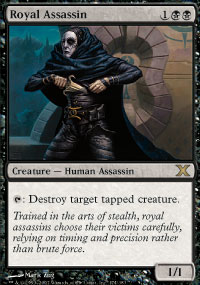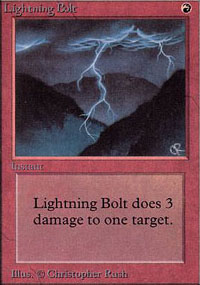 The surest way to lose a close multiplayer contest is by not recognizing the real threat. Multiplayer formats involve more than beating one deck. You need to determine not just whom to cast spells at and attack but the order in which you will eliminate those opponents. Spending your own resources to hammer a single opponent who wasn't dangerous can help one player win. A player other than you. Only act if it will helps to quell your biggest threat. Emotional revenge, 'because you can', wanting credit for knocking someone out, or even giving up are not reasons to target someone. You may not need to target them now, but keep in mind, they are your main obstacle to winning later. So how do you recognize a threat when there are four other players staring back at you? In stages. The major threats, in order of importance, are board position, cards in hand, deck theme, and life total. This is, for lack of a better term, a 'how-to' for each.
The surest way to lose a close multiplayer contest is by not recognizing the real threat. Multiplayer formats involve more than beating one deck. You need to determine not just whom to cast spells at and attack but the order in which you will eliminate those opponents. Spending your own resources to hammer a single opponent who wasn't dangerous can help one player win. A player other than you. Only act if it will helps to quell your biggest threat. Emotional revenge, 'because you can', wanting credit for knocking someone out, or even giving up are not reasons to target someone. You may not need to target them now, but keep in mind, they are your main obstacle to winning later. So how do you recognize a threat when there are four other players staring back at you? In stages. The major threats, in order of importance, are board position, cards in hand, deck theme, and life total. This is, for lack of a better term, a 'how-to' for each.
[caption id="attachment_814" align="alignright" width="200" caption="back-stabbing is part of magic"] [/caption]
[/caption]
The most obvious threat is the player with superior board position. If there is no clear superior board position among players, go down the 'threat list'. Determine who has the most cards in their hand, size up the deck types each player is piloting, and check the life totals. With the most threatening board position (other than you) established, plan your next move. The best way to handicap board position is removal. So that is where you want to aim that Cruel Edict, or Sudden Spoiling/Pyroclasm combo. When the choice is do nothing, make sure you can defend yourself in case of any attack . Never assume because you did nothing to them, that your enemy will return the favor.
A fistfuls of cards is the second threat and is nearly as dangerous as board position. Nothing is worse than fighting to the finale of a long game, only to be unloaded on by the seven cards your opponent has saved up. The caveat here is total mana. A player with many cards needs the mana available to play them. Holding six cards means nothing if they only have three mana to use them. The best approach to defeating card advantage cards is discarding, or forcing use, drawing out spells by attacking and targeting. It is important not to let this player sit back and watch, that is just what they want. This strategy was detailed in a previous article.
[caption id="attachment_815" align="alignleft" width="200" caption="assume your opponent has a few of these in hand"] [/caption]
[/caption]
While combating the first tier of threats, it is important to keep in mind the second tier. First among these is the decks your opponents are playing. Each deck has a folly, and your folly should be your biggest concern. For example; creatures heavy decks need to focus on creature destruction decks, and not so much burn decks. It seems counter-intuitive but remember, to achieve victory every opposing deck must be vanquished. Never use valuable resources making the easy kill. Those resources are more valuable against a deck that counters them. The goal is to make it a two player game where you have the deck advantage, and not the other way around. So do not be afraid, send your troops into the void. Your next turns will be that much better.
The last major threat indicator is life total. There is certainly no easier thing to evaluate. However, consider the following factors. The difference between two players at 10 life can be vast. Especially when one is playing mono-red burn, and the other has a Spirit-Linked Force of Nature. Common sense is handy here, but as a general rule a player under five life is not a threat unless everyone is at or around 5 life. All else being equal, focus your efforts on the player with the most life. Many duels between the final survivors are decided simply by who started with the most life.
Each of these threat types needs to be evaluated using your own instinct and feel for the game and players. These are only loose guidelines for play. Every game is different. However, if you lose after it becomes mano-y-mano look to these guidelines. Patterns exist even in defeat. Maybe it is your opponent weilding a fistful of cards, or fourteen elves, or maybe a life total too high to beat. The key is to deal with these issues before the game is decided. It is a guaranteed way to up your winning percentage in multiplayer, and make the games more balanced and fun. Next time your group shuffles up for a five-way game you'll be prepared.

























